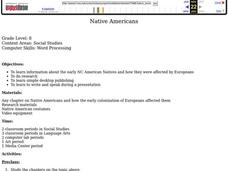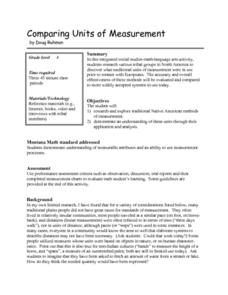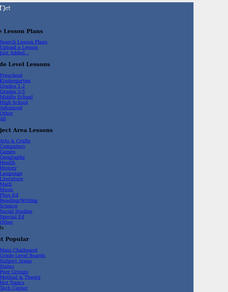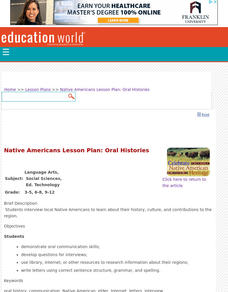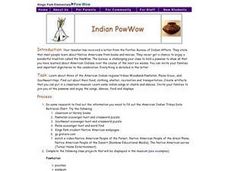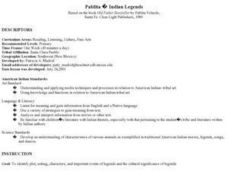Curated OER
Documenting Where We Are
Students contribute to discussions and identify how an artist elicits a viewer's response. They use William Henry Jackson's Pawnee Indian Village, photograph and painting. After analyzing this information, students use information gained...
Curated OER
Native Americans
Eighth graders are assigned a group of Native Americans from the North Carolina area to study. They research and write a paper, including sections on family, government, food, clothing, shelter, European contact, artifacts and give an...
Curated OER
Wappo Indians of Napa County
Third graders describe the American Indian nation in their local region long ago and in the recent past in terms of national identities, religious beliefs, customs, and various folklore traditions. They synthesize their findings into a...
Curated OER
The Treaty Trail: U.S. Indian Treaty Councils in the Northwest
Young scholars create a timeline with the major events of the 19th and 20th century dealing with Native Americans. They examine artifacts and discuss how they reflect culture. They also identify trade routes the Native Americans used.
Indian Land Tenure Foundation
Leaders' Decisions and Actions
Community leaders try to make choices that protect the community and the environment. Little ones learn about how tribal communities look to their chief to guide the decision-making process. Your class will become part of the community...
Curated OER
If These Objects Could Talk
Students examine American Indian artifacts through historical, cultural and artistic lenses. They explore the philosophy behind the Smithsonian Institute's new museum to honor American Indian history and traditions.
Curated OER
Comparing Units of Measurement
Fourth graders investigate the units of measurement used by various Native American tribes before they had contact with the Europeans. They write research questions, conduct research using a variety of resources, in small groups write a...
Curated OER
Native American Legends, Folk Stories and Tales
Students write an Indian tale explaining a natural event, an animal characteristic,
Curated OER
Native Lands: Indians in Georgia , Losing Ground: Removal, 1802-1838
Students investigate the removal of the Creek Indians from Georgia. Students read the story of the Creek removal from Georgia, locate sites mentioned on a map, and create a related timeline. Students share their thoughts on the Creek...
Curated OER
Village Life in India
Learners use included links to research the lives of people living in a small village in India.
Curated OER
Memorandum Regarding the Enlistment of Navajo Indians
Young scholars examine the Navajo dictionary used by the U.S. military in W.W. II. They role-play Navajo messengers and Marine Corp staff. They research the Battle of Iwo Jima and confirm or discount the claim that Navajos made the...
Curated OER
Myth and Truth: The First Thanksgiving
Encourage learners to think critically about common myths regarding the Wampanoag Indians in Colonial America. They discover that behind every myth are many possible explanations—and that learning more about American history helps them...
Curated OER
Chief Sealthe's Speech
Students explain the conflict over land between Native Americans and the United States government. They evaluate Native American values and the results of the U.S. expansion into Native American lands.
Curated OER
Does This Belong to You?
Fourth graders examine legislation that has been passed to protect the rights and religion of Native Americans. In groups, they discuss their feelings on others taking artifacts from Native American sites and what they do if they find...
Curated OER
WINTER-STORYTELLING
The student evaluate illustrations in a book, identify a story or book as distinctly Native American, draw original illustrations for a story, create a flip book, listen attentively to stories from a known storyteller, act out a story,...
Curated OER
Oral Histories
Pupils interview local Native Americans to explore their history, culture, and contributions to the region. They contact a local Native American organization, conduct an interview with a volunteer and write thank-you notes.
Curated OER
Buffalo-Ta Tanka
Pupils study the buffalo. They watch a video and read a story about the buffalo and what it meant to Native American Indian tribes. They practice naming the parts of buffalo in Lakota.
Curated OER
Indian PowWow
Learners identify three different American Indian regions and tribes, their food, clothing, shelter, recreation, and transportation. Students create artifacts that can be placed in a museum. Learners sing songs, chants, and dance. ...
Curated OER
Worth a Thousand Words
First graders examine the significance of the American bison to the American Indians of the Great Plains. They create a story in pictographs in the style of American Indians of the Plains.
Curated OER
Prehistoric Indians
Fourth graders identify the four Native American groups of Wisconsin. They compare the four groups through discussion and list the four groups with their tools, food, shelter, and time period.
Huntington Library
Further Exploration - Exploring the California Missions
How did Native Californians and Franciscans influence one another in early California? Learners analyze a few cultural pieces to examine the impact that integration had on Franciscan and Native Californian culture.
Curated OER
Pablita Indian Legends
Scholars are introduced to the characteristics of a legend. They read and discuss Old Father Story Teller by Pablita Velarde. Then, in groups, they write and illustrate a poem based on one of the legends from the book. This lesson plan...
Curated OER
Anasazi Basket Weaving
The Anasazi Indians of Mesa Verde are the focus of this art and social studies lesson. Working in pairs or groups of three, students utilize computers and go online to search for websites about the Anasazi. Students will choose two or...
Curated OER
Social Studies: Native american Tribal Sovereignty
Pupils examine the issue of tribal sovereignty for Native Americans. Following a mock trial simulation based on the case of Johnson v. McIntosh, they write opinion papers based on the results of the Supreme Court decision in 1823.



